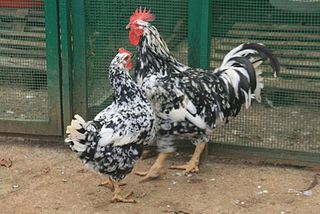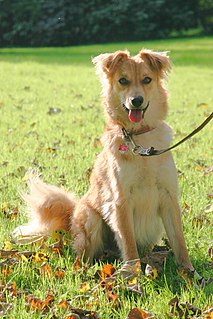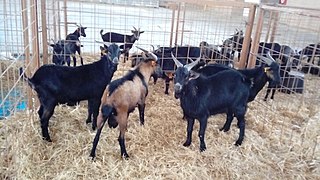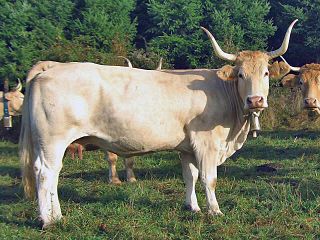
The Pita Pinta Asturiana is the only breed of chicken indigenous to the principality of Asturias, in north-western Spain.

The Sayaguesa is an endangered Spanish breed of domestic cattle. It is named for the comarca of Sayago in the province of Zamora, in the western part of the autonomous community of Castile and León, and is raised almost exclusively in that area. It may also be known as the Zamorana, the Moles de Sayago or the Castellana variedad Sayaguesa. It was traditionally kept mainly for draught work, but is now raised principally for meat.

The Basque Shepherd Dog, Basque: Euskal Artzain Txakurra, Spanish: Perro de Pastor Vasco, is a traditional Spanish breed of sheepdog originating in the historic Basque Country. It is believed that they originated from Central European herding dogs.

The Verata is a traditional Spanish breed of domestic goat. It is a dual-purpose breed, reared both for its meat and for its milk. It is named for, and is thought to originate in, the comarca of La Vera, in the province of Cáceres, in the northern part of the autonomous community of Extremadura in western central Spain. It is one of two traditional goat breeds in Extremadura, the other being the Retinta Extremeña.

The Can de Palleiro is a traditional Spanish breed of shepherd dog from the autonomous province of Galicia in north-western Spain. It was recognised by royal decree in 2001, and the stud-book was established in the same year. It is named after the haystack (palleiro) near which it traditionally sleeps.
Murciana, also called Murcian, Murcien, Murciene and Royal Murciana is a dual-purpose breed of goat originally bred in the Murcia province along the Mediterranean coast of southeastern Spain. The main milk-producing goat breed in Spain is a cross between the Murciana and the Granadina goat known as Murciano-granadina goat. Only the latter is officially recognized by the Spanish government, so Murciana goats are considered a variety of such breed.

The Asturcón is an ancient breed of small horse or pony from the autonomous region of Asturias in northern Spain. It has been documented since Roman times: it has an unusual ambling gait, which was described by Pliny the Elder in his Naturalis Historia. It is of Celtic type, and shows similarity to the Pottok and Losino of Spain, the Garrano of Portugal, and the Dartmoor, Exmoor, Fell, Highland, Shetland and Welsh breeds of the British Isles.

The Burguete is a Spanish breed of horse from the autonomous community of Navarre in north-eastern Spain. It is listed in the Catálogo Oficial de Razas de Ganado de España in the group of autochthonous breeds in danger of extinction. It is reared principally for horsemeat.

The Zamorano-Leonés is a breed of large domestic donkey from the provinces of Zamora and León, in the autonomous community of Castilla y León, in north-western Spain. The name derives from those of the two provinces.

The Castellana Negra or Gallina Castellana Negra is a Spanish breed of domestic chicken. It is a good egg-laying breed, rustic and disease-resistant. It was formerly widely kept and commercially exploited in Spain. Since the advent of imported commercial hybrid layer chickens and the spread of highly intensive chicken farming methods, it has almost disappeared.

The Euskal Oiloa, Spanish: Gallina Vasca, is a breed of domestic chicken from the autonomous community of the Basque Country in north-eastern Spain and south-western France. It is the traditional rural chicken of the area, a rustic dual-purpose breed of Atlantic type, and differs from Mediterranean Spanish breeds such as the Castellana Negra and the Minorca in several respects: it has yellow legs and feet, red earlobes, and lays brown eggs.
The Pasiega is a traditional Spanish breed of red dairy cattle from the autonomous community of Cantabria in northern Spain. It originated in the Valles Pasiegos in south-eastern Cantabria. The name derives from that of the Pas River, which flows through that region. Because of the colour of its coat it may also be known as the Roja Pasiega or Rojina.

The Palmera is an endangered breed of cattle from the island of San Miguel de La Palma, in the Spanish autonomous community of the Canary Islands. The cattle are not indigenous to the island, but were brought by European settlers in the fifteenth century. The Palmera derives from the Rubia Gallega breed of Galicia. It is distributed mostly in the municipalities of Breña Alta, Breña Baja, El Paso, Garafía, Los Llanos de Aridane and Villa de Mazo, with small numbers in the municipalities of Puntagorda, Santa Cruz de La Palma and Tijarafe; a few may be found on the islands of Fuerteventura and Tenerife.

The Menorquina is an endangered breed of cattle from the Mediterranean island of Menorca, in the Spanish autonomous community of the Balearic Islands. It belongs to the group of convex-profiled red cattle, whose distribution across the northern Mediterranean region is thought to have followed the path of the Bell-Beaker Culture. It is one of only two autochthonous Spanish breeds of dairy cattle, the other being the Pasiega. The milk is particularly suitable for cheese production, and is used to make Mahón cheese, which has DOP status.

The Albera is an endangered breed of small cattle indigenous to the Albera Massif, which divides Catalonia from France and lies partly in the comarca of Alt Empordà in the Catalan province of Girona, and partly in the comarca of Vallespir in the French département of Pyrénées-Orientales. The cattle are highly resistant to cold, though susceptible to heat, and are well adapted to the steep terrain of the massif.

The Bruna dels Pirineus, Spanish: 'Bruna de los Pirineos', is a breed of cattle from the south-eastern Pyrenees, in the northern part of Catalonia. It derives from cross-breeding of local cattle with Swiss Braunvieh stock imported in the nineteenth century through France and through the Val d'Aran. It is distributed throughout the northern comarcas of Catalonia, Alta Ribagorça, Alt Urgell, Berguedà, Cerdanya, Pallars Jussà, Pallars Sobirà, Ripollès, Solsonès and Val d'Aran. The Bruna dels Pirineus constitutes about 80% of the beef herd of Catalonia.

The Pirenaica, Basque: Behi-gorri, is a breed of beef cattle indigenous to the Pyrenees of north-eastern Spain. It is distributed mainly in the autonomous communities of Navarre and the Basque Country, but is present in much of the northern part of the country. It is well adapted to the mountainous terrain and humid climate of the area. It came close to extinction in twentieth century, but is not now at risk.
Granadina is a Spanish breed of goat. It is one of the olderst livestock breeds of Spain, being mentioned in 15th century sources. Its milk-producing characteristics were documented in 1893 and it was officially recognized in 1933. However, since 1975, it is considered a variety of the Murciano-granadina goat, which is a cross between the Murciana goat and the Granadina goat. Only the Murciano-granadina breed is officially recognized by the Government of Spain. Murciano-granadina goats have become the primary milk-producing goat breed in Spain, while the Granadina variety is rare. Its first germplasm bank was created in 2010 to combat its loss of genetic diversity.

The Monchina, Basque: Behi montxina, is a Spanish breed of mountain cattle indigenous to the autonomous communities of Cantabria and the Basque Country in northern Spain. It is related to the Betizu and possibly to the Terreña breeds of cattle of the Basque Country, and is closely associated with the Villano de las Encartaciones breed of dog, which is traditionally used in managing it. It is classified by the Ministerio de Agricultura, Pesca y Alimentación, the Spanish ministry of agriculture, as a "Raza Autóctona en Peligro de Extinción" or native breed at risk of extinction.
















